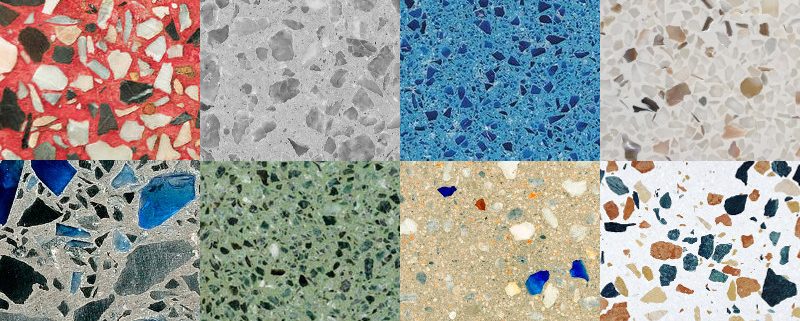What is Terrazzo Flooring
A form of flooring called terrazzo has been used for more than 500 years. It has great historical significance. It is a composite material of glass, quartz, marble, or granite fragments set in a cement or epoxy matrix. After that, the material is polished to provide a smooth, long-lasting, and attractive surface. It has recently been more well-liked as a resilient, eco-friendly, and adaptable option.
Types of Terrazzo Flooring
There are two primary forms of this flooring: cement-based and resin-based.
The original kind is based on cement. It is made of Portland cement blended with marble or granite fragments. To create a homogeneous surface, the mixture is poured over a concrete or wooden subfloor and then levelled and smoothed.
The mixture is ground and polished when dried to create a smooth and long-lasting surface. Because of its longevity and ease of maintenance, it is a cement-based & preferred option for high-traffic places like airports, schools, and hospitals.
Conversely, it has been made using a two-part epoxy resin, and marble or granite chips are known as resin-based terrazzo. The material is placed over a subfloor to achieve a consistent surface and then levelled. The mixture is ground and polished to create a smooth and long-lasting surface when dry.
Since it is resin-based & more malleable than cement-based, it is better suited for high-traffic areas. It is also available in a broader range of colors and patterns than cement-based, making it a popular choice for designers and architects.
Benefits of Terrazzo Flooring
They offer several benefits, including:
Durability
It is highly durable and can last for decades with proper maintenance. It can withstand heavy foot traffic, making it an ideal choice for high-traffic areas.
Low Maintenance
It is easy to clean and maintain. It requires regular sweeping and mopping to keep it looking its best.
Versatility
This floor is a flexible option for commercial and residential applications since it comes in a massive assortment of colors & patterns.
Eco-Friendliness
It is an environmentally beneficial choice because it is manufactured from natural components like marble and granite chips. It also lasts a very long, so it only requires replacement as frequently as other flooring materials.
Hygienic
Since this is non-porous, it cannot contain bacteria or other pathogens or absorb moisture. This makes it a clean option for public places like hospitals and schools.
Aesthetic Appeal
A touch of refinement can be added to any environment with its unique and attractive appearance. High-end houses, hotels, and restaurants frequently choose it.
Cons of Terrazzo Flooring
While it offers many benefits, there are also some cons to consider, including:
Cost
It can be expensive, especially if you opt for a custom design or pattern. Installation costs can also be high due to the specialized tools and equipment required.
Slipperiness
It can be slippery when wet, making it a potential safety hazard in bathrooms or entryways.
Susceptibility to Cracking
While this is durable, it is not entirely immune to cracking. Over time, the concrete subfloor underneath the terrazzo can shift, causing cracks in the surface. This can be especially problematic in areas with heavy foot traffic or where heavy objects are moved around.
Complexity of Installation
It requires specialized knowledge and equipment to install. Improper installation can lead to several issues, including uneven surfaces, cracking, and discoloration.
Maintenance
While this is relatively easy to maintain, it does require regular attention to keep it looking its best. Failure to clean and maintain this properly can lead to discoloration and staining.
How to Maintain Terrazzo Flooring
Maintaining this flooring is relatively straightforward. Here are some tips on how to keep your terrazzo flooring looking its best:
Sweep or Vacuum Regularly
Dirt, dust, and debris can scratch the surface of your floor, so it’s important to sweep or vacuum it regularly to keep it clean.
Mop with a Mild Cleaner
It should be mopped with warm water and a mild cleaner. Avoid using abrasive cleansers since they might harm its surface.
Use a Sealer
Using a sealer, it can be shielded against stains and damage. While applying the sealer, be sure to follow the manufacturer’s directions.
Clean up Spills Immediately
Accidents happen, so cleaning up spills immediately is essential to prevent them from staining your floor.
Avoid Harsh Chemicals
Avoid harsh chemicals on your terrazzo flooring, such as bleach or ammonia, as they can damage the surface.
Don’t Drag Heavy Objects
Avoid dragging heavy objects across your terrazzo flooring, as this can scratch the surface. Instead, lift large objects or use furniture pads.
Conclusion
It is a resilient, sustainable, and versatile flooring option. Because of its unique designs and simplicity of maintenance, it is a popular choice for residential and commercial structures. Whether striving for a classic or modern appearance, when discussing with a decorative concrete services company this is an option to consider.





Leave a Reply
Want to join the discussion?Feel free to contribute!